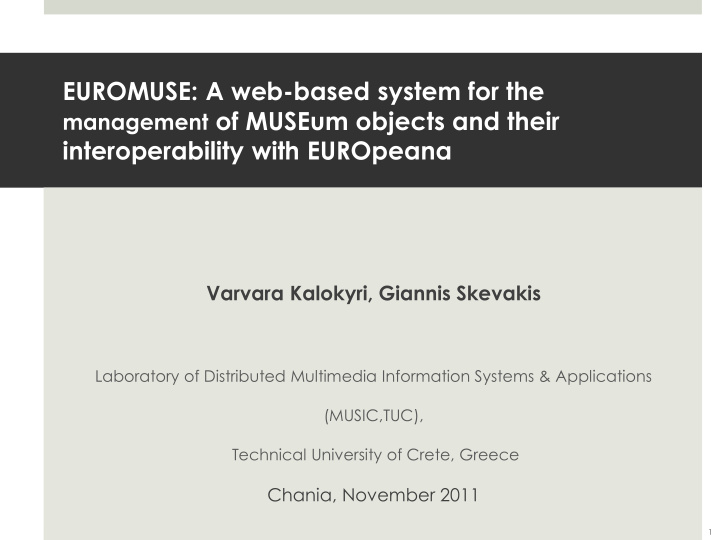



EUROMUSE: A web-based system for the management of MUSEum objects and their interoperability with EUROpeana Varvara Kalokyri, Giannis Skevakis Laboratory of Distributed Multimedia Information Systems & Applications (MUSIC,TUC), Technical University of Crete, Greece Chania, November 2011 1
Overview Motivation Contribution Background technologies Functional specification The ESE-CHO Application Profile System Architecture GUI Design Specification Implementation Evaluation Conclusion 2
Motivation Expansion of the traditional model of museums to include high resolution images of their exhibits Acceleration in the digitization of information. Increasing capacity of digital information storage. Interconnection of museum objects with the outside world for exploration from any place with Internet connectivity Museums don’t have the ability to purchase a complex system for publishing , organizing and authoring museum objects Lack of semantic linkage with already published global vocabularies Lack of a system that supports standard-based metadata description of museum objects 3
Motivation Europeana foundation Started by the presidents of major European nations Financed by the member states and eu programs Europeana internet portal web portal exposing increasingly impressive amounts of digitized cultural heritage objects from various sources throughout Europe. Main purpose : enable people to explore the digital resources of Europe's museums, libraries, archives and audio-visual collections. Contribution from 1500 European institutions (Louvre, British Library) More than 15.000.000 items 4
Overview Motivation Contribution Background technologies Functional specification The ESE-CHO Application Profile System Architecture GUI Design Specification Implementation Evaluation Conclusion 5
Contribution EuroMuse Allows the publishing of cultural heritage objects Facilitates the authoring and metadata enrichment of cultural heritage objects Establishes the interoperability between museums and Europeana Provides seamless ingestion of legacy metadata. 6
Contribution Main features Web-based management system Shared access for multiple users with concurrency control mechanisms Supports a rich metadata element set (ESE-CHO Application Profile) Semantic linkage of the objects with well-established controlled vocabularies Supports a variety of the most popular multimedia formats. 7
Contribution Developed in the context of Natural Europe project. Connect the digital collections of European Natural History Museums with Europeana Used by NHMs Natural History Museum of Crete National Museum of Natural History Jura-Museum Eichstaett Arctic-Center Estonian Museum of Natural History Hungarian Natural History Museum Already includes over 2000 fully described museum objects Target:16.000 museum objects 8
Overview Motivation Contribution Background technologies Functional specification The ESE-CHO Application Profile System Architecture GUI Design Specification Implementation Evaluation Conclusion 9
Background technologies XML/XML Schema Set of rules for encoding documents in machine-readable form. Description of a type of xml document. XML Beans Java to XML binding framework RDF Standard language for representing information about resources in the World Wide Web Europeana Semantic Elements (ESE) Google Web Toolkit (GWT) Simple Knowledge Organization System (SKOS) 10
Background technologies Europeana Semantic Elements (ESE) Dublin-Core based application profile Generic terms applied to heterogeneous materials Metadata as simple text descriptions Mandatory elements Recommended elements Optional elements Elements supplied by Europeana dc:title dcterms:alternative dc:format europeana:country dc:description dc:creator dcterms:extent europeana:language dc:language dc:contributor dcterms:medium europeana:uri europeana:dataProvider dc:date dc:identifier europeana:usertag europeana:isShownAt dcterms:created dc:rights europeana:year europeana:isShownBy dcterms:issued dcterms:provenance europeana:provider dcterms:temporal dc:relation dc:subject dc:publisher dcterms:conformsTo dc:type dc:source dcterms:hasFormat/isFormatOf dc:coverage dcterms:isPartOf dcterms: hasVersion/isVersionOf dcterms: spatial europeana:object dcterms:isReferencedBy/references europeana:rights dcterms:hasPart europeana:type dcterms:isReplacedBy/replaces dcterms:isRequiredBy/requires dcterms:tableOfContents europeana:unstored 11
Background technologies Europeana Semantic Elements (ESE) Example 12
Background technologies Google Web Toolkit (GWT) What is GWT? framework for Rich Internet Applications (RIA) web application with desktop characteristics extensive use of Ajax enhanced interactivity and improved user experience Better responsiveness and information flow Provides a set of core Java APIs to write RIAs. Compiles client-side Java code to highly optimized cross-browser compatible JavaScript. Developed and used by Google. Open source and completely free. Recommended by Europeana 13
Background technologies Google Web Toolkit (GWT) Why use GWT? UI development similar to Swing (desktop applications). No need to write HTML / JavaScript, but can if desired. Use CSS for formatting. Full IDE support – easy development and debugging. Send complex Java types to and from the server Data gets serialized across network. Documentation Learning Time Slow compilation 14
Background technologies Simple Knowledge Organization System (SKOS) Model for expressing the basic structure and content of thesauri , classification schemes , taxonomies , or any other type of structured controlled vocabulary . RDF format concepts can be composed and published on the Web machine readable and linked with data on the Web Concept skos:prefLabel skos:altLabel skos:broader skos:narrower etc. 15
Overview Motivation Contribution Background technologies Functional specification The ESE-CHO Application Profile System Architecture GUI Design Specification Implementation Evaluation Conclusion 16
Functional requirements Easy to install/use Empower the collaboration among curators Metadata Unification CHO Publishing Thumbnail creation Multilingual tool Semantic linkage with well-established controlled vocabularies Schema-independent Flexibility and modularity Highly customizable 17
Functional requirements Create-Read-Update-Delete (CRUD) CHO CHO Metadata CHO Collection CHO Collection Metadata Support different user categories Specific access rights Guest (Review CHO collection/CHO metadata) Curator (CRUD CHO collection/CHO metadata) Administrator (CRUD user accounts, CHO collection/CHO metadata) 18
NHM Metadata Lifecycle Scenario Existing Published Metadata CHOs 1 2 3 4 19
Overview Motivation Contribution Background technologies Functional specification The ESE-CHO Application Profile System Architecture GUI Design Specification Implementation Evaluation Related Work Conclusion 20
ESE-CHO Application Profile A superset of Europeana Semantic Elements (ESE) The ESE-CHO Application Profile consists of the following parts: Basic information (e.g. title, creator) Life Cycle information (e.g. date created) Technical information (e.g. medium, extent) Relation information (e.g. is part of) Collection information(e.g. title, subject) Europeana information (e.g. data provider, country) 21
Overview Motivation Contribution Background technologies Functional specification The ESE-CHO Application Profile System Architecture GUI Design Specification Implementation Evaluation Conclusion 22
System Architecture EuroMuse has been developed as a RIA. RIAs require complex code on the client side to handle user interaction and other operations. 23
System Architecture Client Side Logic Resides on the user’s web browser Interaction with the users. Presentation of the information. Communication with the server. Design Patterns: Model View Presenter Observer Mediator 24
25
Implementation 26
System Architecture Server Side Logic Resides on the web server hosting the system. Follows a multi-layered architectural pattern . Strict interaction between layers 3 layers Service Business Logic Data 27
28
Recommend
More recommend